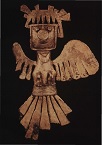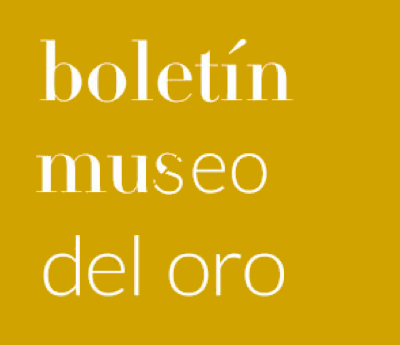El deterioro de aleaciones de oro y algunos aspectos sobre su conservación
Resumen
El oro en su estado original -ya sea obtenido de depósitos de veta o de aluvión- generalmente contiene cantidades significativas de plata (usualmente de 5% a 45% por peso) y frecuentemente un poco de cobre (alrededor de 0.1%-5%) como las impurezas principales que lo acompañan. Altos porcentajes de plata, a partir de 40% y más constituyen aleaciones naturales de color verde pálido o plateado. Esta aleación también pudo ser elaborada a partir de la adición de plata extraída de la veta, a oros que contuvieran bajos niveles de impureza de plata. El cobre también puede ser añadido para fabricar un rango de aleaciones que van de un oro moderadamente degradado -que contiene de un 5% a 15% de cobre- hasta cobre que contenga pequeñas cantidades de oro (cerca del 0.5%-5% ). Se cree que pequeñas cantidades de oro fueron añadidas en algunas aleaciones de cobre para modificar las características de coloración de la superficie, luego de varias formas de tratamiento de ésta.
Referencias bibliográficas
GOWLAND, W. The Metallurgy of Non-Ferrous Metals. 3rd. ed., C. Griffin, London (1921).
NEEDHAM, J. Science and Civilization in China, vol. 5, Cambridge University Press (1974), págs. 245-257.
CRADDOCK, P. T. Gold in Antique Copper Alloys. En: Gold Bulletin 15 (1982), págs. 69-72.
TYLECOTE, R. R. A History of Metallurgy. The Metals Society, London (1976), págs. 37-38.
CLARKE, R. R. the early iron age treasure from Snettisham, Norfolk. En: Proceedings of the Prehistoric Society 20 (1954), págs. 27-86.
LECHTMAN, H. N. The gilding of metals in pre-Columbian Perú. En: Application of Science in Examination of Works of Art Ed. W. J. YOUNG, Museum of Fine Arts, Boston (1973), págs. 38-52.
DAS, H. A. y ZONDERHUIS, J. The analysis of electrum coins. En: Archaeometry, 7. (1964), págs. 90-97.
SCOTT, D. A. Depletion gilding and surface treatment or gold alloys from the Nariño area of ancient Colombia. En: Journal of the Historical Metallurgy Society. (En proceso de publicación).
RAPSON, W, S. Effects of biological systems on gold. En: Gold Bulletin, 15 (1982) págs. 19-20.
VERNON, W. H. J. Tamishing of silver and silver alloys. Section IV of first experimental report to the atmospheric corrosion research committee. En: Transactions of the Faraday Society, 19 (1923), págs. 882-886.
VINAL, G. W. and SCHRAMM, G. N. The tarnishing and detarnishing of silver. En: MetaI Indutstry, 22 (1924), págs. 1, 15, 100, 151, 23 1.
WEISSER, T. Structured questions section. En: Corrosion and Metal Artifacts.. Ed. D. F. BROWN et, al., NDS Special Publication 479, US National Bureau of Standards. Washington D.C. (1977), pág. 228.
TAMMANN, G., y BRAUNS, E. Das Verhalten von Gold und Legierungen mit Silber und Kudfer gegen Salhpetersau re and Schwelsaure. En: Zeitschríft fur anorganische und allgemeine Chemie, 200 (1931), págs. 209-231.
GERMAN, R. M. The role of microstructure in the tarnish of low gold alloys. En: Metallography, N (1981), págs. 253-266.
WISE, E. M. Gold and gold alloys. En : The Corrosion Handbook. Ed. HH. UHLIG, J. Willey & Sons, New York (1984), págs. 112-1 19.
TUCCILLO, J. J. y NIELSEN, J. P. Observations of onset of sulph ide tamiksh on goldbased alloys. En: Journal of Prosthetic Dentistry, 25 (1971), pág. 629.
McDONALD, A. y SISTARE, G.II. The metallurgy of some carat gold jewellery alloys: Part 1 - coloured gold alloys. En: Gold Dulletin 11, (1978), págs. 66-73.
TAMMANN, G. Die Chemischen und galvanischen Eigenschaften von Mischkrista leallreinhen und ihre Atomverteilung. En: Zeitschrift fur anorgarnische und allgemeine Chemie, 107 (1919) págs. 1-240.
TAMMANN, G. y WILSON C. Die Anderung des galvanischen Potentials der Metalle usw. En: Zwirchrift für anorganische Chemie, 173 (1928), págs. 156-263.
GRAF, L. y ATA, H. D. K. Untersuchung der Spannnungskorrosions-empfindichkeit von Einund Vielkristallen aus Messing und Kupfer-Gold-Legierungen. En:Zeitschrift fur Meutalkunde, 64 (1973), págs. 366-371.
GRAF. I. The causes and the mechanism of stress corrosion cracking of homogeneus non-supersaturated alloys as derived from experimental work with alloys containing noble metal components. En: The Theory of Stress Corrosion Cracking in Alloys - The Proceeding of a Research Evaluation Conference: Ed. J. C., SCULLY, NATO Scientific Affair Division, Brussels (1971), págs. 399-417.
FORTY, A. J. Micromorphological studies of the corrosion of gold alloys. En: Gold Bulletin, 14 (1981), págs. 25-35.
KUHN, A. T. Anod1ic dissolution, oxygen reduction and corrosion of gold alloys. En: Surface Technology, 31 (1981), págs. 17-31.
TISSOT, P., LUTHY, H., y MONNIER, D. Comportement anodique d'alliages or-cuivre en solution aqueuse de NaCI. En: Chimia, 27 (1973), págs. 15-18.
JULEFF J. X-Ray diffraction studies of gold. BSc Dissertation, University of London, Institute of Archaeology, 1981 (Sin publicar).
WISE. E. M. (Ed). Gold: Recovery, Properties and Applications. Van Nostrand, New Jersey (1964).
GRAF, L, BUDKE, J. Zum problem der Spannungskorrosion homogener Mschkristalle III: Abhangigkeir der Spannungskorrosions-empfindlichkeit von Kupfer-Gold und Silber-Gold Mischkristallen von Goldgehalt und Zusammenhang mit dem "Mischkristallen -Effect ". En : Zeilschift fur Matalkunmde, 46 (1955), págs. 378-385.
PICKERJNG, H. W. y WAGNER, C. Electrolytic dissolution of binary alloys containing a noble metal. En : Journal of the Electrochemical Society, 114 (1961), págs. 698-706.
FORTY, A. J. y ROWLANDS. G. A possible model for corrosion pitting and tunneling in noble metal alloys. En: Phillosophical Magazine, 43 (1981), págs. 171-188.
SCOTI, D. A. y SEELEY, N. J. The examination of a gold alloy chisel from ancient Colombia. En: Journal of Archaeological Science. (En proceso de publicación).
Archivo General de Indias. Averiguaciones en Tamalameque sobre los Manyllas que mandó hacer Juan de Azpeleta a Jos Yndios de su encomienda de Anpihuegas (1555). Justicia, legajo 610-612, folios 25-20-25 manuscrito. Archivo General de Indias Sevilla (traducción que reposa en el archivo del Musco del Oro de Bogotá).
HULTGREN, R. y TARNAPOL. L. Effect of silver on gold copper superlatice Au - Cu. En: Transactions of the American Institute of Mining and Metallurgical Engineers, 133 (1939), págs. 228-237.
YAMAUCHI, H. YOSHIMATSU, A.R. FORDUIII, A., y DEFONTAINE, D. Phase reactions in copper-silver-gold ternary alloys. En: Precious Metals, Proceedings of the Fourth International Precious Metals Institute Conference, Pergamon Press, Toronto (1981), págs. 214-249.
PINNEL. M.R. y BENNETT, J. E. On the formation of the ordered phases CuAu and Cu3Au at a cooper/gold planar interface. En: Metallurgical Transactions A 1 A (1979), págs. 741-747.
EILERTSEN, K. A. Mounting technique for fragile metal objects. En: Studies in Conservation, 26 (1981), págs. 17-79.




